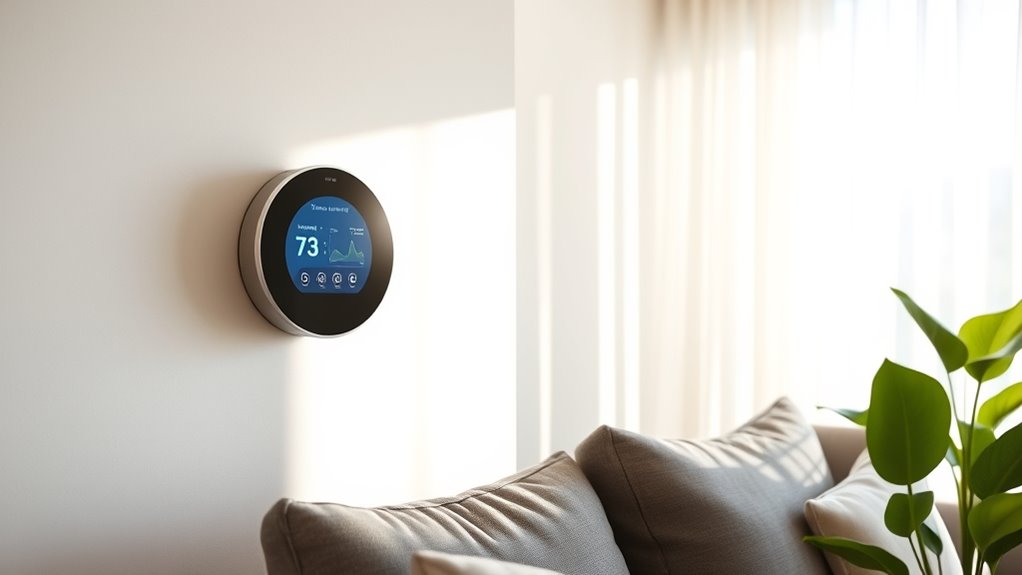If you’re looking for smart thermostats that learn your routines to cut energy costs, I recommend models like ecobee, Nest, and Sensi. These devices use occupant learning algorithms to automatically create heating and cooling schedules, optimizing comfort and savings. Many support voice control and smart home integration too. To find the best fit for your home and budget, I’ll guide you through the top options that combine efficiency, ease of use, and advanced features. Keep going to discover which one suits you best.
Key Takeaways
- Many top smart thermostats feature self-learning algorithms that automatically optimize heating and cooling schedules for energy efficiency.
- Compatibility with various HVAC systems and easy DIY installation make these thermostats accessible for most homes.
- Integration with voice assistants and smart home platforms enhances automation and remote control capabilities.
- Occupant detection and room sensors improve comfort while reducing energy waste through adaptive adjustments.
- These thermostats can deliver significant cost savings, often recouping their price within months through reduced energy bills.
meross Smart Thermostat for Home

If you’re looking for a smart thermostat that’s easy to install and compatible with most HVAC systems, the meross Smart Thermostat for Home is an excellent choice. It supports 95% of systems, including conventional heating and cooling, heat pumps, and heating-only models. Installation is quick, typically taking just 30 minutes with the app’s setup wizard. It requires a C-wire for proper operation, or you can use the Meross adapter if needed. The thermostat connects only to 2.4GHz Wi-Fi, ensuring stable remote control. Overall, it’s a reliable, user-friendly option for managing your home’s climate efficiently.
Best For: homeowners seeking an easy-to-install, versatile smart thermostat compatible with most HVAC systems and offering remote control and smart home integration.
Pros:
- Supports 95% of HVAC systems, including heat pumps and conventional setups
- Quick installation within 30 minutes using the app setup wizard
- Enables remote management and scheduling via the Meross app, with local control even when Wi-Fi is disconnected
Cons:
- Requires a C-wire for proper operation or the use of a Meross C-wire adapter
- Only compatible with 2.4GHz Wi-Fi networks, limiting connectivity options
- Not suitable for electric baseboard heaters, which are incompatible with this thermostat
ecobee Smart Thermostat Enhanced, Wifi Programmable Thermostat
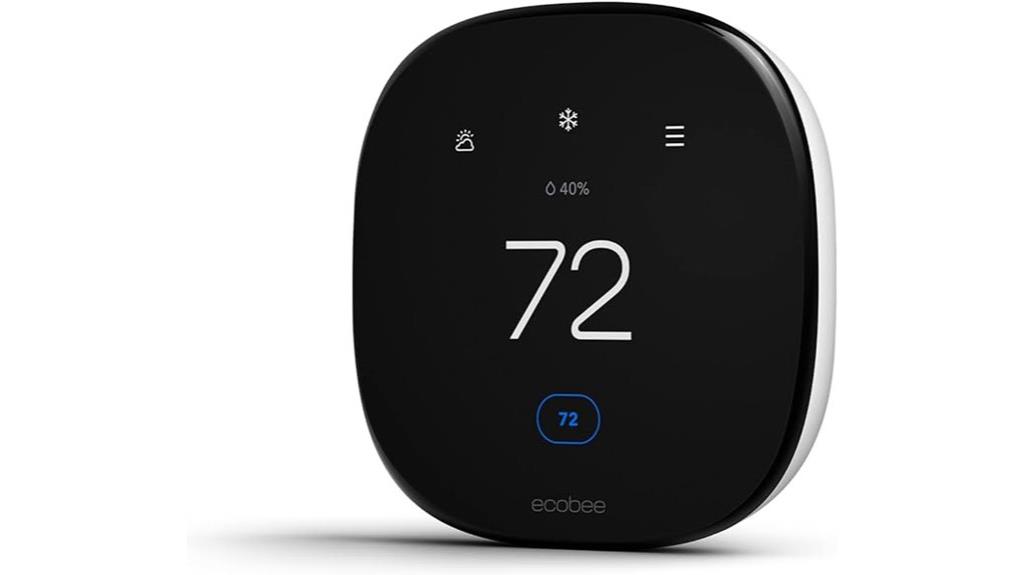
The ecobee Smart Thermostat Enhanced is an excellent choice for homeowners seeking to maximize energy savings and comfort through intelligent control. It can save up to 26% annually on heating and cooling costs by automatically adjusting temperatures when you’re away, preheating or precooling your home before you arrive, and managing humidity levels for consistent comfort. With SmartSensor technology, it monitors room-specific temperatures, focusing on key areas. Compatible with major smart home platforms like Siri, Alexa, and Google Assistant, you can control it remotely via the app or voice commands. Its easy installation, Energy Star certification, and wide HVAC compatibility make it a versatile, efficient upgrade for any home.
Best For: homeowners seeking a smart, energy-efficient thermostat that offers remote control, easy installation, and compatibility with major smart home platforms.
Pros:
- Saves up to 26% annually on heating and cooling costs through intelligent adjustments.
- Compatible with most HVAC systems and supports smart home integrations like Alexa, Google Assistant, and Siri.
- Easy to install with features like the Power Extender Kit and user-friendly operation.
Cons:
- May require additional accessories like the Power Extender Kit for certain installations.
- Advanced features and app integrations could have a learning curve for some users.
- The unit relies on Wi-Fi, so connectivity issues may affect remote control and automation.
Google Nest Learning Thermostat (4th Gen, 2024) with Nest Temperature Sensor
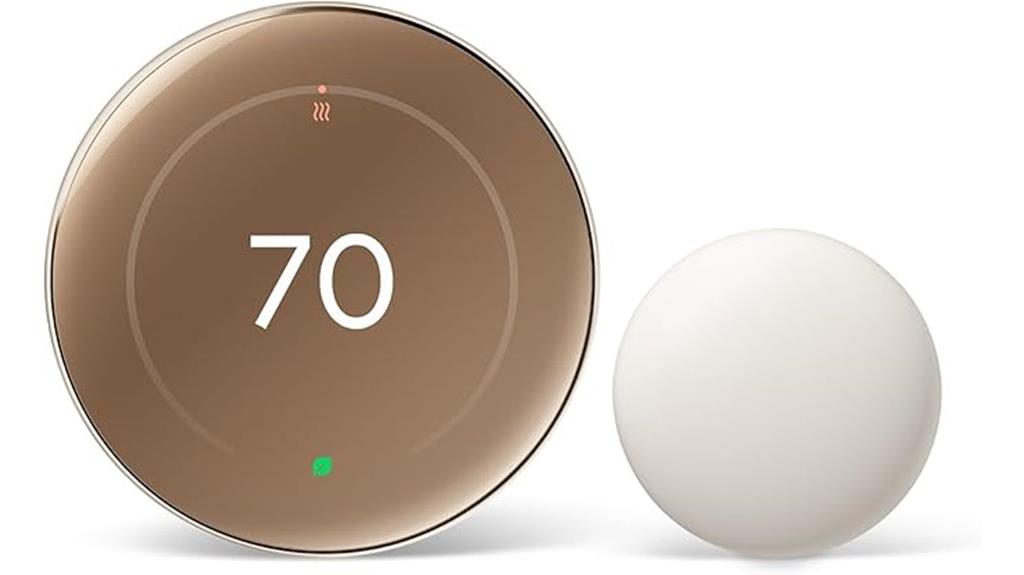
The Google Nest Learning Thermostat (4th Gen, 2024) with Nest Temperature Sensor is ideal for homeowners seeking a highly intelligent system that adapts effortlessly to their routines. It works with most 24V systems, often without needing a C wire, and integrates seamlessly with Matter-compatible devices. Its sleek design features a larger display with Dynamic Farsight for easy viewing from across the room. The thermostat learns your habits over time, optimizing energy use automatically. With the Nest Temperature Sensor, you can manage hot and cold spots in different rooms, ensuring personalized comfort while maximizing energy savings. Control is simple via the app or voice commands.
Best For: homeowners seeking an advanced, self-learning thermostat that offers seamless smart home integration, personalized comfort, and energy savings.
Pros:
- Adaptive self-learning features that optimize heating and cooling schedules automatically
- Large, dynamic display with Better visibility and easy access from across the room
- Compatible with multiple smart home platforms including Matter, Alexa, Siri, and Google Assistant
Cons:
- May require professional installation for complex systems or additional sensors
- Higher upfront cost compared to basic thermostats
- Some users might find the numerous customization options overwhelming at first
Sensi Touch 2 Smart Thermostat with Touchscreen

Designed for homeowners seeking an intuitive, easy-to-use thermostat, the Sensi Touch 2 stands out with its sleek LCD touchscreen and smart control capabilities. It offers programmable scheduling, Wi-Fi connectivity, and voice control via Alexa, Google Assistant, and Samsung SmartThings. ENERGY STAR certified and compliant with Title 24, it’s simple to install with an intuitive app guiding setup. Compatible with most HVAC systems, it supports room sensors for balanced comfort. With features like remote access, usage reports, and maintenance alerts, it helps save around 23% on energy costs. Its modern design and reliable performance make it a popular choice for those wanting smart, energy-efficient control.
Best For: homeowners seeking an easy-to-use, energy-efficient smart thermostat with modern design and reliable performance.
Pros:
- Sleek LCD touchscreen with intuitive interface for easy control and setup
- Compatible with popular voice assistants like Alexa, Google Assistant, and Samsung SmartThings
- Supports room sensors for balanced comfort and energy savings
Cons:
- Limited temperature adjustment ranges for auxiliary heat and low-temperature settings
- Some users experience difficulty accessing outside temperature data on the thermostat
- Variability in technical support response and potential hardware reliability issues
Google Nest Learning Thermostat, 3rd Gen
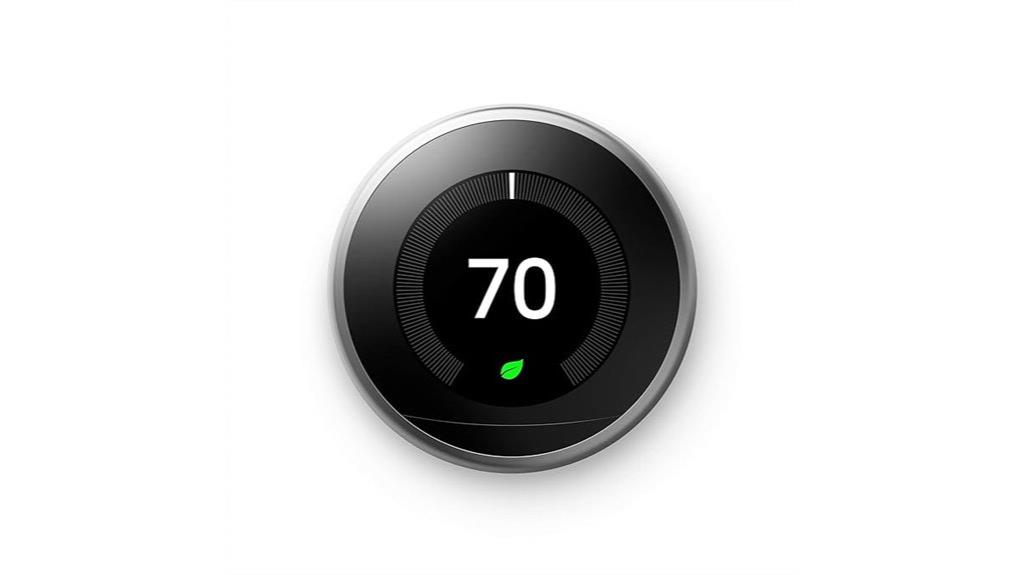
Are you looking for a smart thermostat that actively learns your preferences to save energy and boost convenience? The Google Nest Learning Thermostat, 3rd Gen, fits the bill perfectly. It automatically creates a heating and cooling schedule based on your habits, so you don’t have to program it manually. It shows your energy history and encourages efficient choices with the Nest Leaf. With Home/Away Assist, it adjusts temperatures when you’re not home, saving energy. Plus, you can control it remotely via the Nest app. Just make sure your system is compatible before buying, and you’ll enjoy smarter, more efficient climate control.
Best For: homeowners seeking an energy-efficient, easy-to-use smart thermostat that learns their habits and can be controlled remotely.
Pros:
- Learns your schedule automatically, eliminating manual programming
- Helps reduce energy costs with Home/Away Assist and energy-saving features
- Compatible with Alexa and controllable via the Nest app from anywhere
Cons:
- Requires system compatibility check before purchase to ensure proper functionality
- Limited to the features available within the Nest ecosystem and app
- Might be more expensive than basic thermostats without learning capabilities
Google Nest Learning Thermostat (4th Gen, 2024) with Nest Temperature Sensor
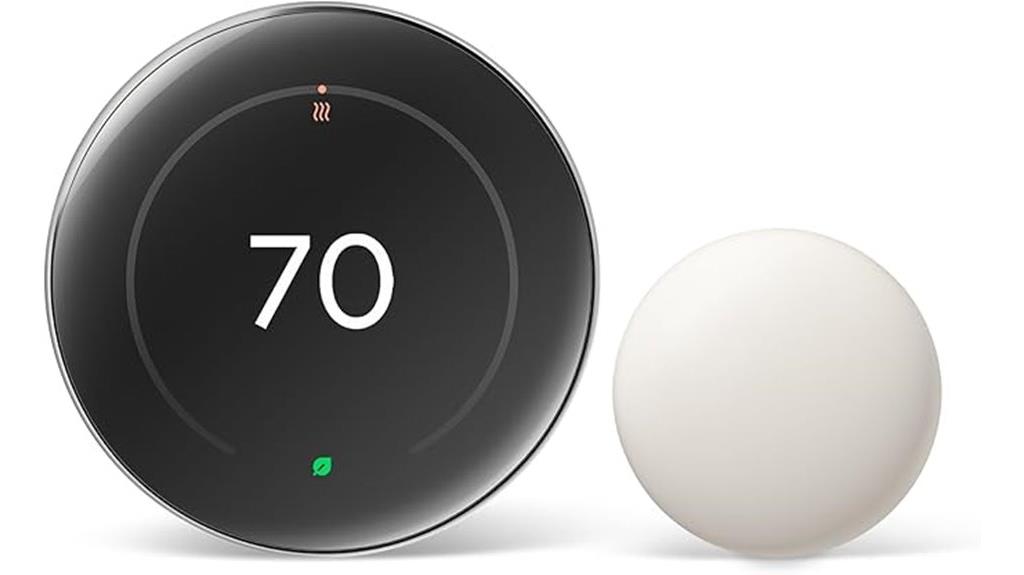
If you want a smart thermostat that seamlessly adapts to your home’s unique heating and cooling needs, the Google Nest Learning Thermostat (4th Gen, 2024) with Nest Temperature Sensor is an excellent choice. It supports most 24V systems without needing a C wire and is Matter compatible, making it easy to integrate into your smart home. The larger, auto-brightness display with Dynamic Farsight makes it easy to see from across the room. With voice control through Alexa, Siri, or Google Assistant and remote management via the Google Home app, it’s perfect for personalized comfort and energy savings, reducing heating and cooling bills considerably.
Best For: homeowners seeking an advanced, energy-efficient smart thermostat that easily integrates with various smart home systems and offers remote control and customization.
Pros:
- Supports most 24V heating and cooling systems without requiring a C wire.
- Features a larger, auto-brightness display with Dynamic Farsight for easy visibility from across the room.
- Compatible with Alexa, Apple HomeKit, and Google Assistant for versatile voice control and remote management via the Google Home app.
Cons:
- May require professional installation if additional sensors or complex wiring are needed.
- The advanced features and compatibility can come at a higher price point compared to basic thermostats.
- Limited information on compatibility with non-24V systems or older HVAC setups.
Google Nest Thermostat, Smart Wifi Thermostat for Home
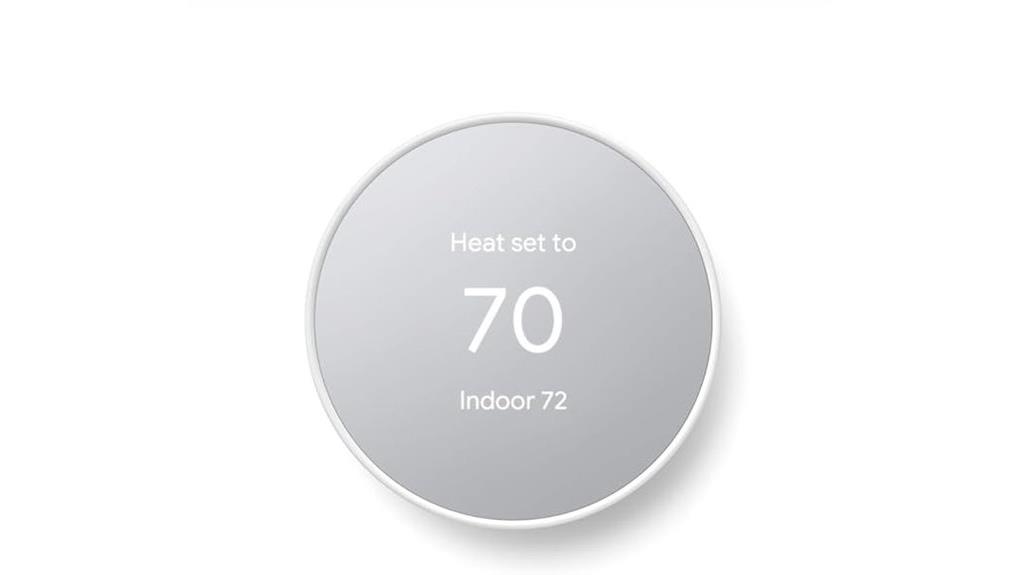
The Google Nest Thermostat stands out as an ideal choice for homeowners seeking to cut energy costs without sacrificing comfort. It’s ENERGY STAR certified, automatically reducing energy use when you’re away, and supports various HVAC systems, including heat pumps. With easy DIY installation and control through Wi-Fi, Google Assistant, or Alexa, it offers remote management from anywhere. Its learning capabilities optimize heating and cooling schedules over time, saving money. The sleek LCD display and intuitive app make adjustments simple. While setup can pose some challenges, its energy-saving features, smart integration, and maintenance alerts make it a reliable, efficient addition to any smart home.
Best For: homeowners seeking an energy-efficient, easy-to-install smart thermostat with remote control and integration capabilities.
Pros:
- Supports a wide range of HVAC systems including heat pumps and supports integration with Google Assistant and Alexa.
- Learns user preferences over time to optimize heating and cooling schedules for energy savings.
- ENERGY STAR certified, helping reduce energy costs and environmental impact.
Cons:
- Installation can be challenging for some users, especially with wiring and system compatibility issues.
- Limited offline functionality; internet outages may impair remote control features.
- Customer reviews indicate occasional difficulties with initial setup and troubleshooting.
Google Nest Learning Thermostat, 3rd Gen
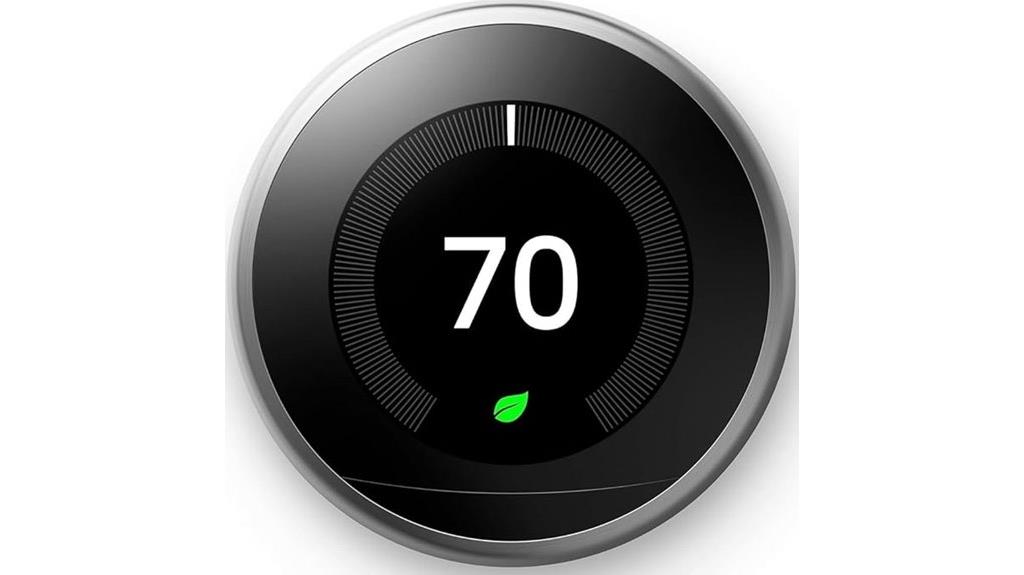
The Google Nest Learning Thermostat (3rd Gen) excels for homeowners who want a smart, self-adjusting climate control system that adapts to their routines. It learns your schedule and preferred temperatures, automatically optimizing comfort and energy efficiency. With features like Home/Away Assist, it switches to Eco Temperature when you’re gone, saving energy. You can control it remotely from your phone or tablet, and it works seamlessly with voice assistants like Alexa. It also monitors your HVAC system, providing alerts and maintenance reminders to keep everything running smoothly. Optional Nest Temperature Sensors help customize room temperature, making this thermostat both smart and highly adaptable.
Best For: homeowners seeking a smart, self-learning thermostat that optimizes comfort and energy savings with remote control and integration capabilities.
Pros:
- Learns user schedules and preferences for automatic climate adjustments
- Offers remote control via phone, tablet, or laptop for convenience
- Includes energy-saving features like Home/Away Assist and Energy History review
Cons:
- Requires Wi-Fi connection for full functionality
- Optional Nest Temperature Sensor sold separately may increase overall cost
- May have a learning curve for users unfamiliar with smart thermostats
Sensi Smart Thermostat
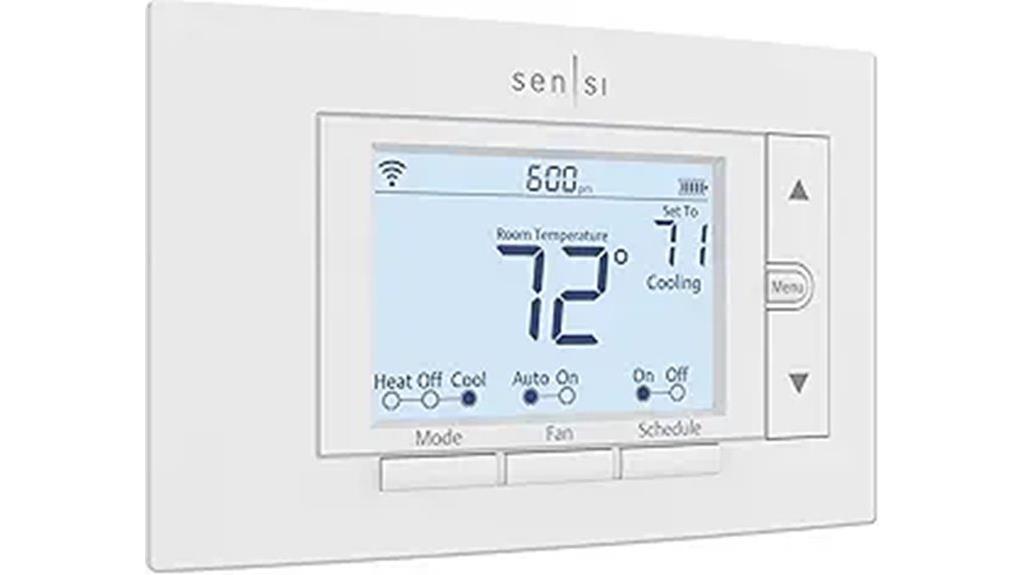
Looking for a smart thermostat that combines easy DIY installation with reliable performance? The Sensi Smart Thermostat (model ST55) fits the bill perfectly. It offers Wi-Fi connectivity, voice control with Alexa and Google Assistant, and a sleek LED display. Installation is straightforward—no patching or painting needed—and it works with most HVAC systems, often without a c-wire. The app makes setup simple, guiding you step-by-step, even if you’re not tech-savvy. With features like scheduling, remote access, and filter alerts, it helps you save about 23% on energy bills. Plus, its dependable design and Energy Star certification make it a smart, cost-effective choice.
Best For: homeowners seeking an easy-to-install, reliable smart thermostat that offers energy savings and compatibility with popular voice assistants.
Pros:
- Simple DIY installation with step-by-step app guidance and no patching or painting required
- Compatible with most HVAC systems, often without needing a c-wire
- Energy Star certified, helping save approximately 23% on energy bills
Cons:
- Limited support for Bixby voice control
- Some users experience occasional connectivity or setting adjustment issues
- Provides limited detailed usage data and system diagnostics
Amazon Smart Thermostat
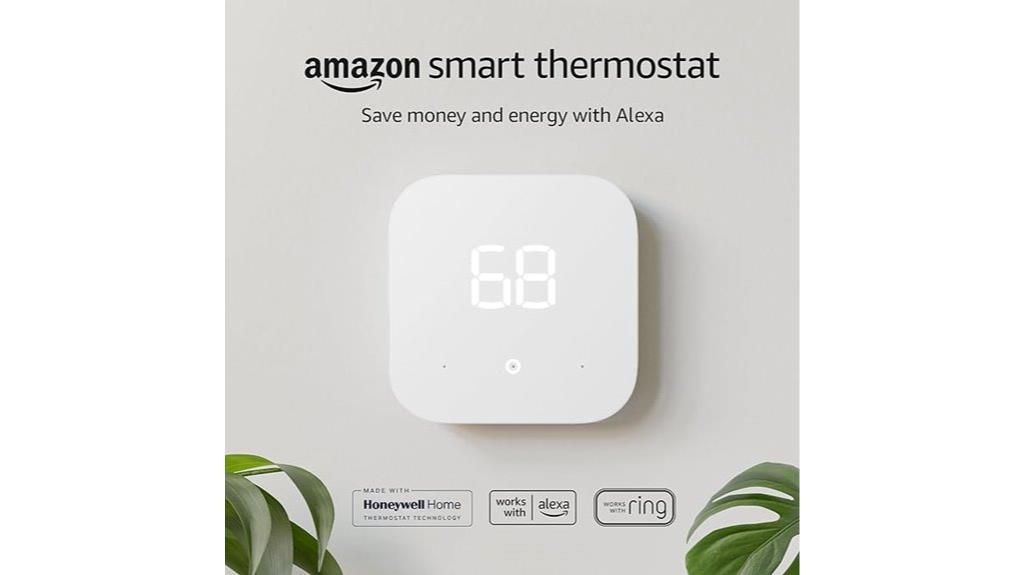
If you want an easy upgrade from traditional thermostats that seamlessly integrates with your smart home, the Amazon Smart Thermostat is an excellent choice. It supports C-wire installation and works effortlessly with Alexa and Ring devices, allowing voice control and smart automation. Compatible Echo models can serve as temperature sensors to address hot or cold spots. The thermostat helps cut energy costs—EPA estimates suggest savings of around $50 annually—and Amazon provides rebate info to lower costs further. With guided installation and reliable support, it’s a straightforward, durable solution backed by Honeywell’s trusted technology, making your home more energy-efficient and convenient.
Best For: homeowners seeking an easy, smart upgrade to their existing thermostat that integrates seamlessly with Alexa and Ring devices for enhanced convenience and energy savings.
Pros:
- Supports C-wire installation for easy setup and compatibility
- Integrates with Alexa and Ring for voice control and automation
- Helps reduce energy costs, with EPA estimates of around $50 savings annually
Cons:
- Limited compatibility with non-Alexa or Ring smart home ecosystems
- May require professional installation if C-wire is not available
- Advanced features depend on a stable internet connection and app support
Google Nest Learning Thermostat (Renewed)
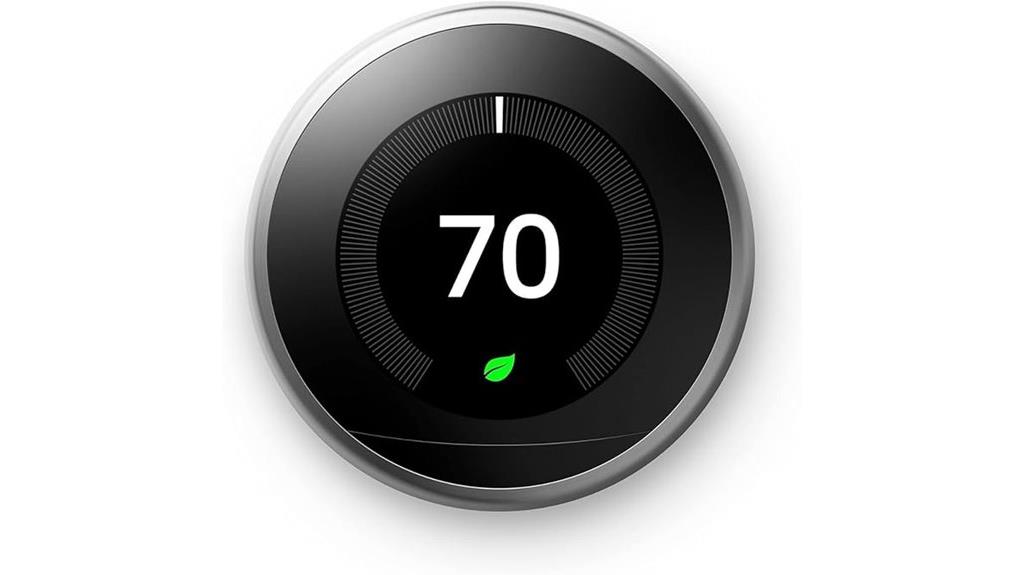
Are you seeking a thermostat that adapts to your habits and helps save energy? The Google Nest Learning Thermostat (Renewed) is a sleek, wall-mounted device compatible with Alexa and Google Assistant. It features an LCD display, stainless steel finish, and easy app or voice control. While many users appreciate its energy-saving capabilities and modern design, some encounter installation challenges, connectivity issues, or faulty units, especially with refurbished models. It’s best suited for simple systems, though complex setups may require professional help. Overall, it’s a smart, energy-efficient choice for those willing to follow proper installation steps and manage occasional technical hiccups.
Best For: homeowners seeking an energy-efficient, modern thermostat that can be easily controlled via app or voice, and are comfortable with potential installation challenges.
Pros:
- Energy-saving features and remote control capabilities via app and voice assistants
- Sleek, modern design with LCD display and stainless steel finish
- Compatible with Alexa and Google Assistant for easy smart home integration
Cons:
- Installation can be complex, especially for multi-zone or wired systems
- Some refurbished units may have connectivity issues or faulty components
- Higher installation costs if not purchased directly from Google or if professional help is needed
ecobee Smart Thermostat Essential, Wi-Fi Programmable Thermostat
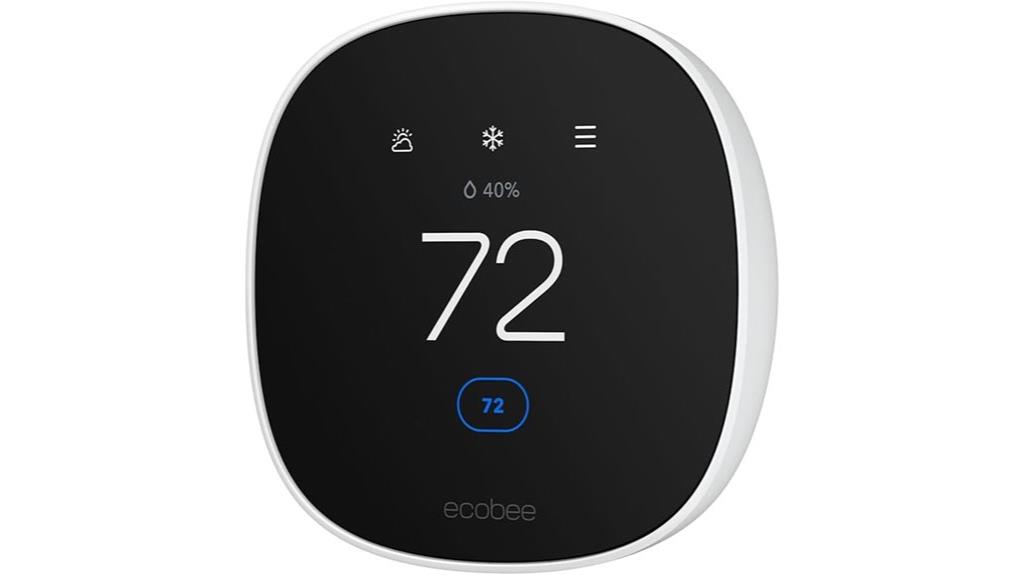
The ecobee Smart Thermostat Essential stands out as an ideal choice for homeowners seeking an affordable, easy-to-install device that delivers significant energy savings. It’s Energy Star certified, Wi-Fi enabled, and compatible with popular smart home platforms like Siri, Alexa, Google Assistant, and Apple HomeKit. I appreciate its straightforward LCD display, touch controls, and auto-scheduling features that optimize heating and cooling. Many users report savings of up to 23%, often paying for the device within six months. Installation is simple for DIYers, especially with its compatibility across various HVAC systems. Overall, it’s a cost-effective upgrade offering convenience, efficiency, and smart home integration.
Best For: homeowners seeking an affordable, easy-to-install smart thermostat that offers energy savings and seamless integration with popular voice assistants and smart home platforms.
Pros:
- Easy DIY installation with compatibility across various HVAC systems
- Significant energy savings, potentially up to 23%, paying for itself quickly
- User-friendly app with intuitive controls and smart home integration options
Cons:
- Limited scheduling flexibility, with only one schedule per season and 30-minute interval adjustments
- Cannot set different schedules for different seasons without manual re-entry
- Basic features like fan control and temperature hold lack advanced customization options
Sensi Lite Smart Thermostat
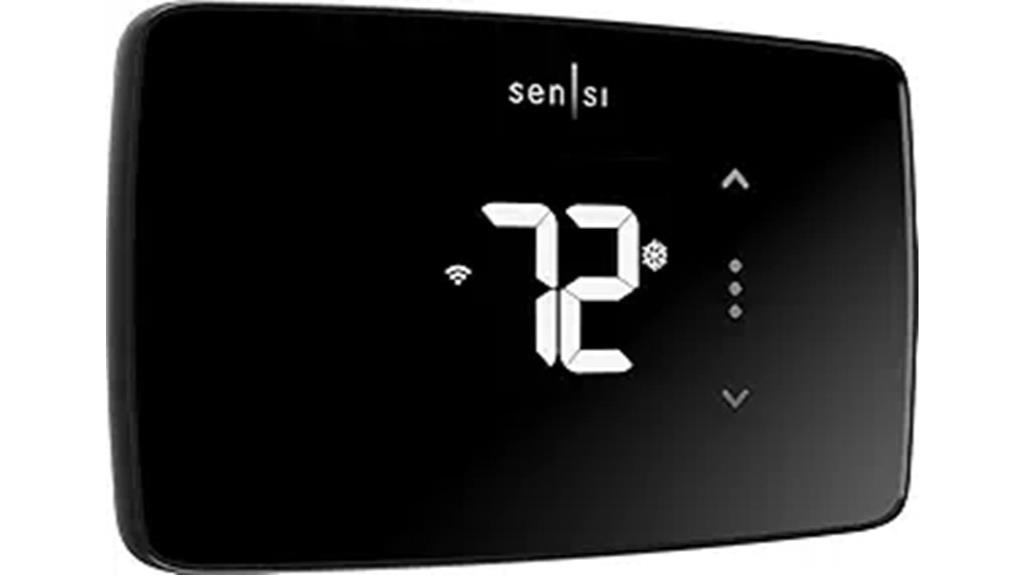
The Sensi Lite Smart Thermostat by Emerson stands out as an excellent choice for homeowners seeking an easy-to-install, energy-efficient device with intelligent scheduling features. It’s Energy Star certified, offering about 23% HVAC energy savings. Its compact design, LCD display, and app control via Wi-Fi make it user-friendly and compatible with most HVAC systems—no C-wire needed in many cases. It supports voice control through Alexa, Google Assistant, and SmartThings. Features like auto changeover, filter indicators, and programmable schedules help optimize comfort and efficiency. Easy DIY installation, combined with remote management, makes it a practical upgrade for those wanting convenience without complexity.
Best For: homeowners seeking an easy-to-install, energy-efficient smart thermostat with remote control and compatibility with voice assistants.
Pros:
- Simple DIY installation with clear instructions and built-in level
- Energy Star certified, providing approximately 23% HVAC energy savings
- Supports app control via Wi-Fi and integrates with Alexa, Google Assistant, and SmartThings
Cons:
- Connectivity issues may occur after power outages or battery changes, requiring re-setup
- Limited scheduling flexibility and detailed usage reports in the app
- Not recommended for use outside the US/Canada, and some users report Wi-Fi performance challenges
ecobee Smart Thermostat Premium with Sensors
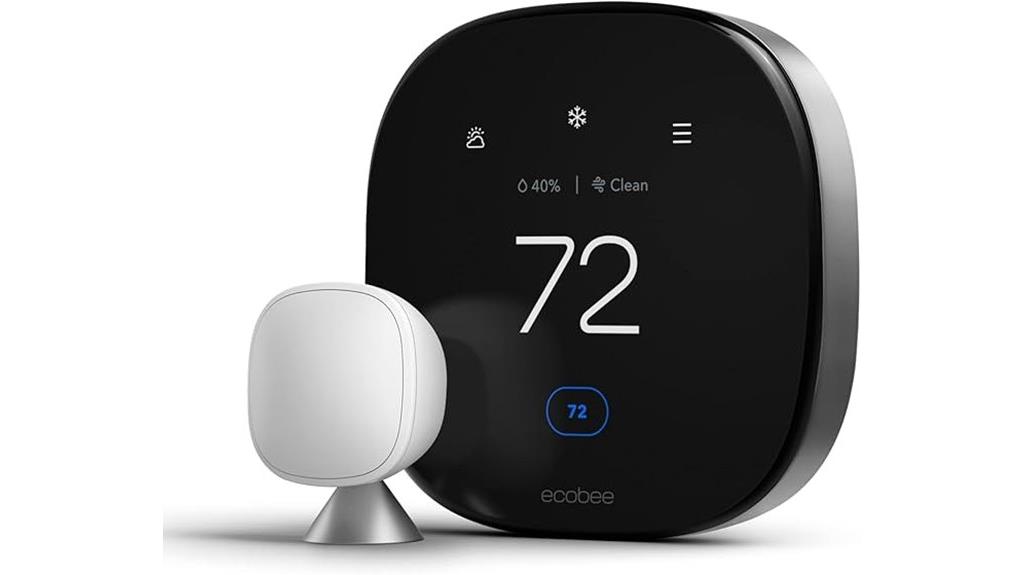
If you want to optimize your home’s comfort and save on energy costs, the ecobee Smart Thermostat Premium with Sensors is an excellent choice. It can save you up to 26% annually on heating and cooling, thanks to its smart sensors that adjust temperature in key rooms and reduce hot or cold spots. It’s ENERGY STAR certified, ensuring energy efficiency. The built-in air quality monitor alerts you to poor air conditions and reminds you to change filters. Plus, it detects open doors or windows and pauses HVAC to save energy. Its sleek design, advanced interface, and compatibility with most HVAC systems make it a top-tier, user-friendly option.
Best For: homeowners seeking to enhance energy efficiency, improve air quality, and integrate advanced smart home features seamlessly.
Pros:
- Saves up to 26% annually on heating and cooling costs with smart sensors and optimized temperature control.
- ENERGY STAR certified, ensuring high energy efficiency and environmental friendliness.
- Built-in air quality monitor and smart sensors provide real-time alerts and improve overall home comfort.
Cons:
- Requires a compatible 24VAC HVAC system and may need additional installation components like the Power Extender Kit.
- Security features such as alerts for break-ins require a separate ecobee Smart Security plan.
- Apple Home Hub is necessary for Siri integration, adding extra setup for Apple users.
ecobee Smart Thermostat Enhanced, Programmable Wi-Fi Thermostat
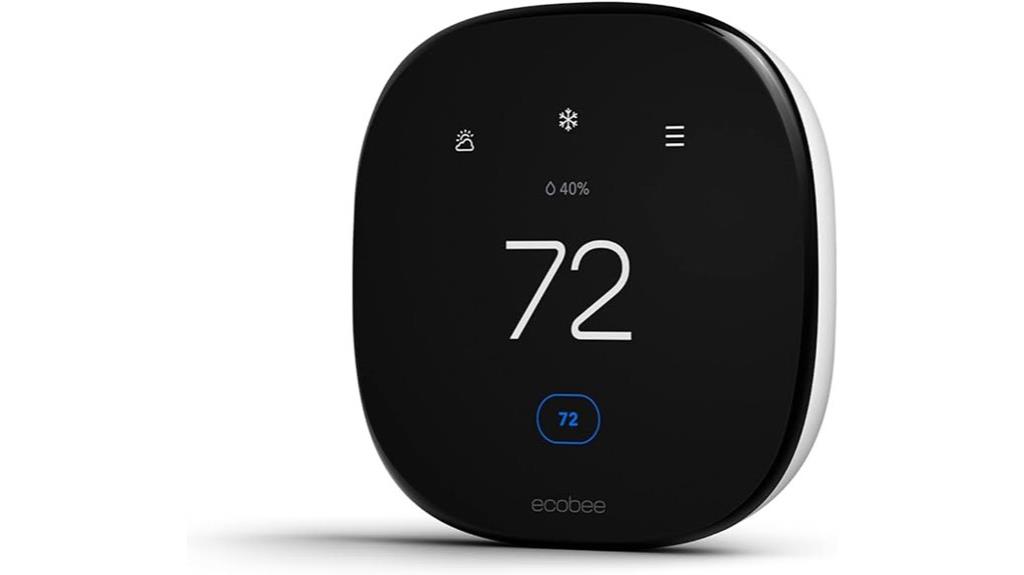
Looking to cut energy costs without sacrificing comfort? The ecobee Smart Thermostat Enhanced helps you do just that, saving up to 26% annually on heating and cooling. It automatically adjusts temperatures when you’re away and preheats or precools your home before you arrive. The thermostat also manages humidity to keep your environment comfortable and uses SmartSensor technology to focus on key rooms. With compatibility across major smart home platforms like Siri, Alexa, and Google Assistant, you can control it remotely via the ecobee app or voice commands. Easy to install and Energy Star Certified, it’s a smart choice for efficient, convenient home climate control.
Best For: homeowners seeking to reduce energy costs while maintaining customized comfort through smart, remote-controlled temperature management.
Pros:
- Saves up to 26% annually on heating and cooling costs.
- Compatible with major smart home platforms like Siri, Alexa, and Google Assistant for seamless control.
- Easy to install with features like Power Extender Kit and Energy Star certification ensure reliable, energy-efficient operation.
Cons:
- May require a C-Wire or Power Extender Kit for certain installations.
- Advanced features and setup might be complex for some users unfamiliar with smart thermostats.
- Limited to 24 VAC HVAC systems, which may exclude some specialized or older systems.
Factors to Consider When Choosing a Smart Thermostat With Occupant Learning Algorithms
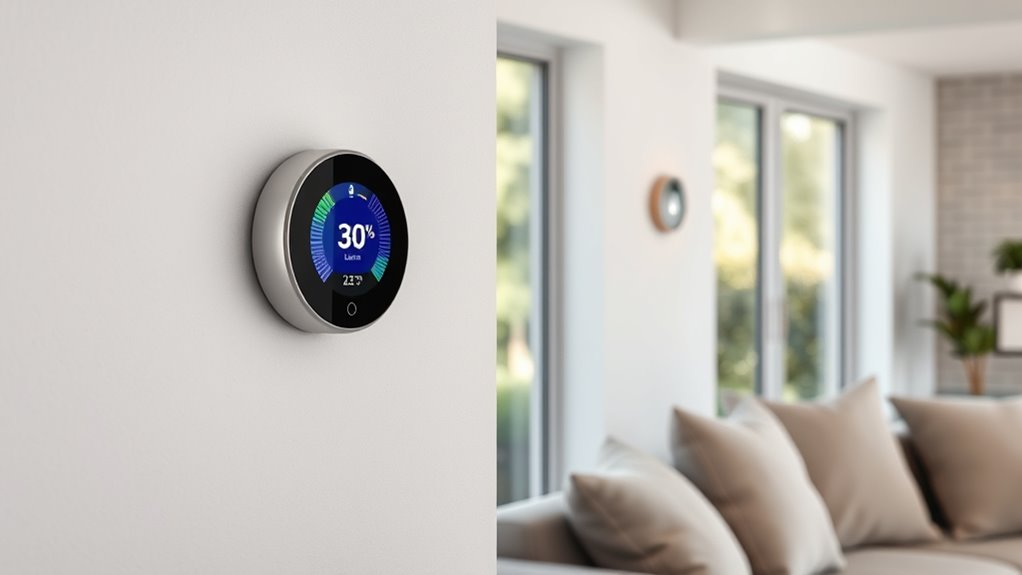
When selecting a smart thermostat with learning algorithms, I focus on how well it works with my HVAC system and how accurate its learning capabilities are. I also consider how easily it integrates with my existing smart home platforms and how simple the installation process is. Ultimately, I look at whether it offers flexible scheduling options to suit my lifestyle.
Compatibility With HVAC Systems
Choosing a smart thermostat with occupant learning algorithms begins with guaranteeing compatibility with your HVAC system. You need to verify that the thermostat matches your system’s voltage and type—whether gas, electric, heat pump, or boiler—to ensure proper operation. It’s also vital to check if it supports features like multi-stage heating or zone control specific to your setup. Compatibility with your existing smart home ecosystem matters too; confirm that it communicates via Wi-Fi, Matter, or other protocols you use. Additionally, review wiring requirements—some thermostats need a C-wire, while others offer power extenders or battery options suited to your wiring. Finally, confirm the thermostat’s learning algorithms are designed to adapt effectively to your system’s control methods and performance characteristics.
Learning Algorithm Accuracy
The accuracy of a smart thermostat’s learning algorithm hinges on how well it interprets your behavior and adapts over time, reducing the need for manual adjustments. Some models use advanced machine learning to analyze occupancy, temperature preferences, and environmental data, optimizing comfort and energy savings. The prediction accuracy can vary considerably, with some thermostats exceeding 90%, while others may require manual overrides if they misinterpret routines. Factors like how often you adjust settings, the consistency of your schedule, and sensor data quality all impact performance. Regular feedback and system corrections can improve accuracy, but initial setup and calibration are vital. Choosing a thermostat with a proven, reliable learning algorithm ensures it adapts effectively, saving you time, energy, and money.
Integration With Smart Platforms
A smart thermostat’s ability to learn and adapt depends not only on its algorithms but also on how well it integrates with your existing smart home ecosystem. To guarantee seamless operation, look for a thermostat that supports popular platforms like Amazon Alexa, Google Assistant, Apple HomeKit, or Samsung SmartThings. Check if it uses Matter technology, which guarantees universal compatibility and simplifies device pairing across ecosystems. The app should allow remote control, scheduling, and automation through your preferred platform’s interface. Compatibility with voice control is also essential for hands-free operation via smart speakers or assistants. Additionally, consider if it integrates with other smart devices, such as sensors or security systems, enabling more comprehensive automation routines that enhance your comfort and energy savings.
Ease of Installation
Installing a smart thermostat with occupant learning algorithms can be straightforward if you pay attention to compatibility and wiring requirements. Most models need a C-wire for consistent power, which simplifies setup and reduces issues. Many devices support DIY installation, offering step-by-step guides and app instructions to make the process easier. Compatibility varies; some thermostats are designed for standard 24V systems, while others may require accessories like Power Extender Kits for complex setups. Thermostats with clear wiring diagrams and detailed online resources often have faster installation times, sometimes under 30 minutes. Supporting multiple wiring configurations can also ease installation for homes with unique HVAC systems. Overall, choosing a model with simple wiring and all-encompassing support makes setup quicker and less stressful.
Scheduling Flexibility
When selecting a smart thermostat with occupant learning algorithms, considering scheduling flexibility is crucial because it directly impacts your comfort and energy savings. A flexible thermostat lets you create multiple, customizable schedules that adapt to your routines or seasonal changes. Some models limit scheduling to one per season or require manual updates, reducing adaptability. The ability to set different temperature schedules for specific times or occupancy states enhances comfort and efficiency. Advanced algorithms may automatically adjust these schedules based on your habits, but having manual override options is essential for control. Compatibility with room sensors can also improve zone-specific scheduling, ensuring each area maintains its preferred temperature. Overall, flexibility in scheduling helps optimize comfort while maximizing energy savings.
Energy Saving Capabilities
Choosing a smart thermostat with occupant learning algorithms can substantially cut down your energy bills by automatically adjusting temperatures based on your habits. These devices analyze your behavior over time to create efficient schedules, reducing unnecessary HVAC use when rooms are unoccupied. Many models use sensors or integrate with existing ones to detect presence or activity, further boosting savings by customizing climate control to actual occupancy. Advanced algorithms can preheat or precool your home before you arrive, ensuring comfort without wasting energy. Additionally, these thermostats monitor HVAC system performance and send maintenance alerts, helping keep everything running efficiently. Overall, these features ensure you’re not just saving energy but doing so intelligently, making your home more sustainable while lowering costs.
Sensor Placement Options
The placement of sensors plays a pivotal role in guaranteeing your smart thermostat with occupant learning algorithms functions accurately. Proper placement helps the system detect activity and temperature preferences effectively across different rooms. I recommend placing sensors in high-traffic areas or rooms you use most, so the thermostat can adapt to your habits. Avoid installing sensors near heat sources, direct sunlight, or drafts, as these can lead to false readings or incorrect occupancy detection. Using multiple sensors to create zones allows for tailored comfort in specific areas, boosting efficiency. Additionally, position sensors where they are easily accessible for maintenance and away from obstructions that could impair their accuracy. Thoughtful sensor placement ensures your smart thermostat learns correctly, optimizing comfort and energy savings.
User Interface Simplicity
A user-friendly interface is essential for maximizing the benefits of smart thermostats with occupant learning algorithms. Clear visuals and intuitive controls make adjusting settings and viewing data straightforward, even for those less tech-savvy. Simplified navigation menus reduce the learning curve, allowing occupants to easily customize schedules and preferences without frustration. Large, high-contrast displays improve readability from different angles and lighting conditions, enabling quick interactions. Responsive touchscreens and minimal menu layers streamline operation, saving time and effort. Additionally, clear feedback and status indicators help users instantly understand current modes, temperature settings, and system activity, minimizing confusion. Overall, an intuitive interface ensures you can effortlessly harness the thermostat’s features, making energy savings and comfort management more accessible.
Frequently Asked Questions
How Do Occupant Learning Algorithms Adapt to Changing Schedules?
When it comes to changing schedules, occupant learning algorithms adapt by constantly monitoring your habits and adjusting the temperature accordingly. I’ve noticed my thermostat learns my routine over time, recognizing shifts in my daily activities. It updates its settings dynamically, ensuring I stay comfortable without wasting energy. So, even if my schedule varies, the system automatically adapts, making my home more efficient and saving me money.
Can These Thermostats Integrate With Existing Smart Home Systems?
You’re wondering if these thermostats can connect with your current smart home setup. Most modern models offer seamless integration with popular platforms like Alexa, Google Assistant, and Apple HomeKit. I’ve found that compatibility varies, so I always double-check before purchasing. Once connected, I enjoy the convenience of controlling my climate from one app or voice command, making my smart home feel more unified and efficient.
What Privacy Measures Are in Place for Occupant Data Collection?
Oh, I love how privacy is the last thing on some folks’ minds when they talk about smart tech. Rest assured, these thermostats have strong privacy measures—encrypted data, user control over info sharing, and transparent policies. I personally appreciate that I can decide what data I share and when, because, honestly, safeguarding my habits and preferences feels just as important as saving energy.
How Do Learning Algorithms Optimize Energy Savings Over Time?
Learning algorithms analyze your daily routines and preferences, adjusting your thermostat settings accordingly. Over time, they identify patterns like when you’re home or away, automatically optimizing temperature levels for comfort and efficiency. This continuous adaptation helps save energy by reducing unnecessary heating or cooling. I find that these algorithms get smarter with use, ensuring your home stays comfortable while cutting energy costs without you having to lift a finger.
Are There Maintenance Requirements for Occupant Learning-Enabled Thermostats?
When it comes to occupant learning-enabled thermostats, maintenance is pretty minimal. I find I just need to keep the sensors clean and update the firmware occasionally to guarantee smooth operation. Sometimes, I check the app for software updates or troubleshoot if the system seems off. Overall, these thermostats are low-maintenance, making it easy for me to enjoy energy savings without extra hassle.
Conclusion
Choosing the right smart thermostat feels like finding the perfect rhythm for your home’s comfort. With occupant learning algorithms, it’s like having a silent partner that understands your habits, saving energy and money effortlessly. As the temperature glides smoothly from cozy mornings to cool evenings, these devices adapt quietly in the background. Trust me, once you set it up, you’ll enjoy a seamless, efficient flow of comfort, making every day a little warmer and a lot smarter.
